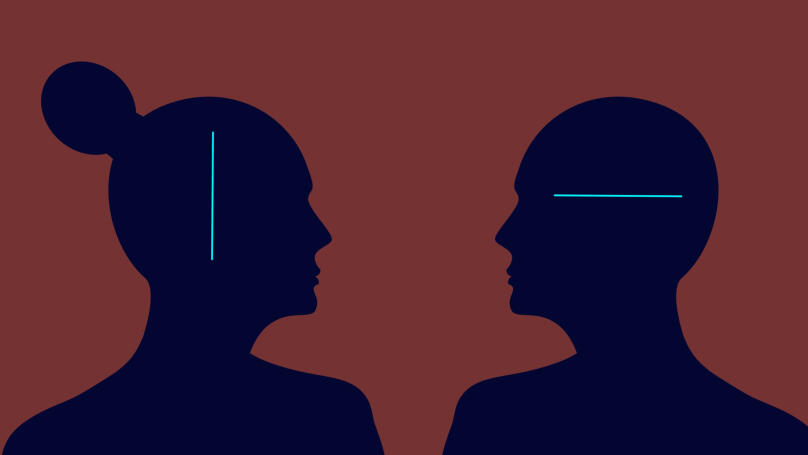"Think about it!!" Lateral thinking and the correct way to apply it
Creativity and imagination are among the most sought-after skills in modern society.

These qualities allow you to think creatively, avoid being labeled, and resist living "by the book." So, let us learn how to develop creative thinking, produce a unique product, and make the work process more exciting and compelling. The method of lateral thinking will help you achieve this!
What is lateral thinking?
Lateral thinking is thinking outside the box and using as many creative approaches as possible to solve particular personal and work problems. Lateral thinking means "vertical thinking." The underlying principles of lateral thinking are quite different from the traditional thinking we are used to. In most instances, we try to think logically, depending on facts and proof, act coherently and rationally, and ultimately choose the best way to solve the problem. However, you can do the exact opposite and equally benefit!
In 1967, the English psychologist Edward de Bono unveiled his new concept of thinking and suggested we forget the logic and not be limited by rules and laws and notice what we were deliberately avoiding before. According to the psychologist, new ways of thinking must occur because of the limitations of logic and the inability to solve all the problems we face in our modern world. Therefore, the most important feature of lateral thinking is abandoning our standard behavior patterns and using an unconventional approach to resolve conflicts and develop creativity. It can also be called divergent thinking, contrary to generally accepted norms. People with this type of logic (more precisely, anti-logic) react far better to unusual situations. They can adapt to even the most severe circumstances.
Methods of lateral thinking: how to improve it and utilize it

1. The six hats method
This is Edward de Bono's method, with whom you are now familiar. It examines a problem from several points of view simultaneously. Remember that your attitude towards a situation represents one of many possible perspectives! The six hats method helps you change the "broken record," which is the set of categories your brain is used to. Therefore, you can look at the situation from a fundamentally new angle. To do this, imagine multi-colored hats, each symbolizing a different point of view and various elements of the same problem. For example:
-
The white hat represents the available information and insights. The first imaginary hat answers the central questions: what do you have, and what do you need to solve the problem?
-
The red hat represents your emotions and feelings about the situation. "Wearing" this hat, you must use your "sixth sense": connect with your intuition and listen to yourself and your feelings.
-
The green hat represents creativity. The possible ways out of your current situation, from the most obvious and straightforward to the wildest and most unlikely solution.
-
The black hat represents the disadvantages. This hat signifies everything that can prevent you from acting on your previously planned ideas. Therefore, you must evaluate all possible risks sensibly and abandon the most dangerous options for solving the problem.
-
The yellow hat represents the benefits and advantages. The yellow hat encompasses the benefits and advantages you will receive after implementing your idea. The person wearing the yellow hat identifies them, sorts through them, and prioritizes them.
-
The blue hat represents your goal and solution. This is the last hat that concludes your analysis of the situation, encapsulates, and organizes the information from all previous hats. Now you need to study all the information and the arguments given in favor of each idea and then choose the most interesting, helpful, and creative one.
The hats are entirely up to you, or you could distribute these roles among team members if you make decisions together. The second option is considered not only more convenient but also more effective.
2. The method of synectic assault
Despite the complicated name, this method is straightforward to use. It will help you break your brain's habitual thinking patterns and look at the problem from an angle that even stereotypes will not prevent you from making the best decision. Using this method includes the following:
- State the problem that has arisen (briefly and in summary.)
- Describe the most common solutions to the problem.
- Think about how someone else (your friend or colleague) would deal with the problem. How would they approach it? What would they do specifically?
- What unconventional method can be used in this case? Produce the strangest and most absurd solution to the problem.
- Imagine how any non-existent character, historical figure, or hero of your favorite work would solve this problem. Now try doing the same!
3. The random word method
This method is useful when other methods have already been tried and you have reached a dead end. So, it is time to use any word you associate with the events occurring! Only within the bounds of decency, of course. Then think about why you thought of that word: compare it with your problem, draw parallels and find a point of contact. This assessment increases the chances of emerging innovative ideas and finding a way out of your current situation.
4. The go-beyond method
Imagine how you could solve the problem if nothing gets in your way. Forget about space, budget, deadlines, and all other restrictions! The essence of this method is to go beyond what is permitted and solve the problem as if you have all the resources for absolutely any outcome. Write down the ideas that come to mind, then examine them and compare them to the reality of the situation. Finally, imagine that there is something that, with a bit of adjustment, could be implemented.
5. The method of analogs
Find and study business cases that are similar to your situation. You can also produce solutions for more straightforward and more evident analogs to your problem and then return to the current circumstances and look at them from the point of view of "learned experience."
6. The focus method
When solving a particular problem, we pay attention only to what needs to be fixed or redone. When our brain examines only one problematic section of a product, try focusing on various parts, areas, and things at once! For example, shift your attention from technical to aesthetic, even if the problem resides with an item's design, size, and shape. How can this be related to functionality or used as a benefit?
7. The recall method
To use this method, you have to challenge public opinion. By giving an idea that has already been rejected and thinking about what is wrong with it and whether it might improve. For example, why did your target audience not like your new product line, and how can you change the situation to your advantage without creating new products but improving existing ones?
Using lateral thinking as instructed by Philip Kotler

Based on the concept of lateral thinking suggested by Edward de Bono, American marketer Philip Kotler devised his universal way of using lateral thinking. The method involves three stages:
-
Choosing a focus. First, you need to focus on a particular problem and consider options solely for its solution. Also, when using lateral thinking, you need to have a basic idea (an idea, a goal, or just a dream), which you can build upon later and will be a creative basis.
-
"The lateral gap." This is what is called breaking conventional boundaries and frameworks. After you have decided to use it as the basis for finding a solution, you need to change stereotypical thinking or create events that are already familiar to you. Stop the pattern, break the logic, and change your focus. Think about something you have never thought about before.
-
Networking. In the second stage, any innovative ideas you come up with may seem ridiculous, but do not rush. Give it a chance! Try to find common sense, a rational and logical aspect to your ideas. This is the most challenging stage of lateral thinking. Still, at the moment, when the entire creative process occurs, the imagination is activated, and there is every chance you could create something revolutionary.
Lectera’s Online Courses by topic
How do you develop lateral thinking?
Thinking freely and being creative is a skill, not an innate talent. However, remember that you need to hone your skills constantly. Otherwise, traditional thinking will again take precedence over creative thinking. To develop the latter, follow some simple rules:
-
Constantly find new ways to perform your normal daily activities, from preparing breakfast to keeping documentation. A new way of performing old actions "revives" the brain's neurons and forces them to restore and create new connections.
-
Regularly come up with stupid and absurd ideas based on events. You can also use an illustrated book or any other pictures. Produce the most improbable version of what is depicted in them. Then, let your imagination run wild and create a funny, dramatic, or scary story.
-
You can do the same with everyday items: think about what else you can use this item for, why it appeared, and who created it.
-
Experiment with yourself! To begin with, you can change your image. This will already be a big step towards eliminating stereotypical and categorized thinking. A change of scenery and new surroundings can also change how you think.
-
Think about how you can use old things creatively.
-
Set aside time in your daily schedule to think about new opportunities, perspectives, and ways to achieve your goals.
-
Learn to enjoy these reflections, searching for innovative ideas and a creative process.
-
Think of a creative hobby and be available for artistic activities.
-
Develop critical thinking, question everything, and double-check information from multiple sources.
-
Use board games to develop logic and thinking. This is a reasonably effective method for developing your imaginative thinking, attention, and memory.
-
Read specialist literature. In addition to the recognized experts in creative thinking, Edward de Bono and his seminal work "Lateral Thinking as a Way to Solve Complex Problems," you can also consult the following books:
- Yakov Perelman "5 minutes to think."
- Luc de Brabander "Think in other formats.”
- Philip Kotler "Lateral Marketing."
Therefore, with the help of lateral thinking, you can free yourself from stereotypes, patterns, and clichés. In addition, this concept provides you with many options for solving work and personal problems. Helping you develop your imagination, allowing you to be creative even throughout the most severe and risky activities! The ability to think creatively will help you always remain in demand and succeed.
Share this with your friends via:
Latest News

A significant stage in the development of the alternative education system has begun in West Northamptonshire in the UK: the County Council is actively calling on parents, guardians, and trustees to participate in shaping the future of this key area.

Outwoods Primary School in Atherstone, Warwickshire, having experienced deep sadness after the loss of their famous cat, Silla, has found solace in a new pet – a Maine Coon named Aloysius O’Hara.

In modern universities, artificial intelligence, and in particular ChatGPT, is rapidly transforming from a controversial tool into a full-fledged student assistant.

An innovative educational project is gaining momentum in UK primary schools, aiming to change attitudes towards video games.

The Massachusetts Institute of Technology (MIT) presents MIT Learn – a revolutionary online platform that opens a “new front door” to access university knowledge and resources.












 Life After the Holidays: How to Beat the Post-New Year Blues
Life After the Holidays: How to Beat the Post-New Year Blues
 Which Christmas Movie Character Are You?
Which Christmas Movie Character Are You?
 Your New Year’s Forecast: What Awaits You in the New Year?
Your New Year’s Forecast: What Awaits You in the New Year?
 Test. What Career Goal Should You Set for Next Year?
Test. What Career Goal Should You Set for Next Year?
 Test. Which New Year Archetype Are You?
Test. Which New Year Archetype Are You?
 Test. How Should You Spend the Winter Holidays?
Test. How Should You Spend the Winter Holidays?
